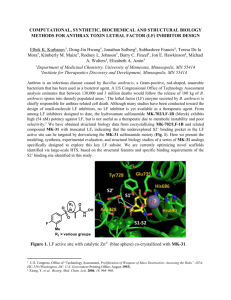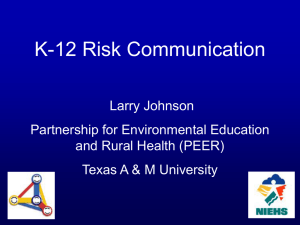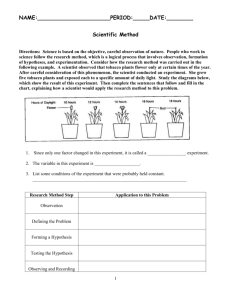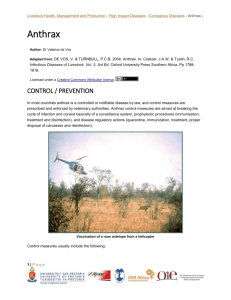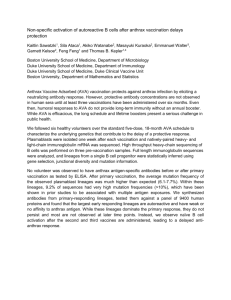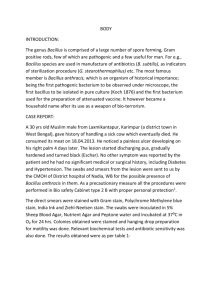anthrax_2_epidemiology
advertisement
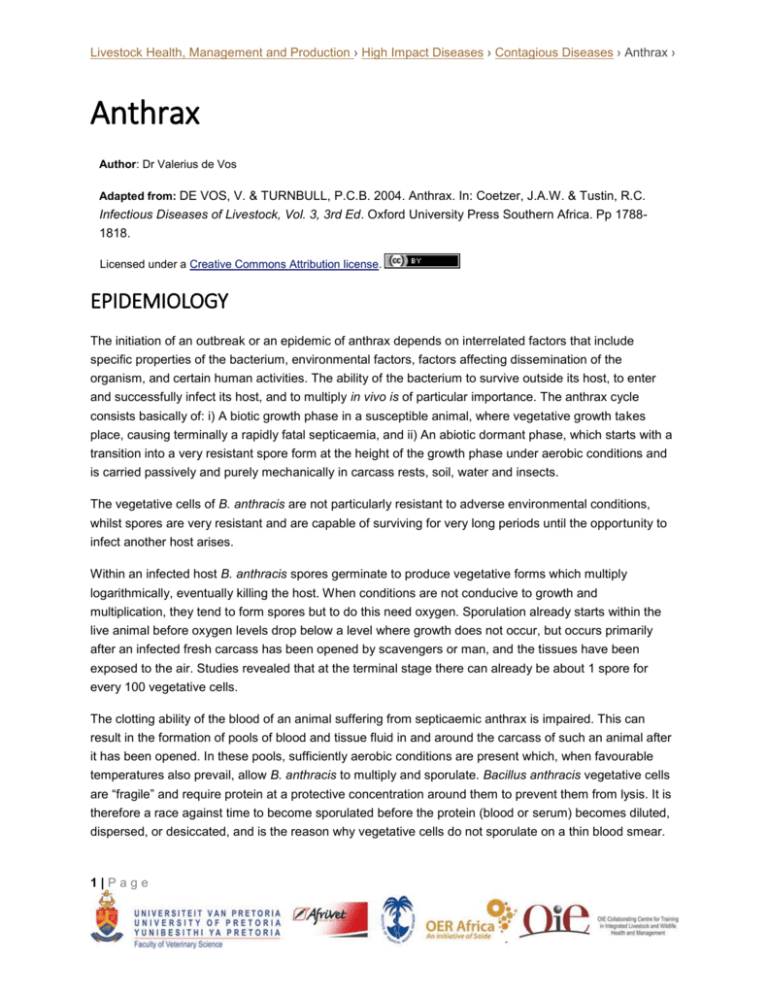
Livestock Health, Management and Production › High Impact Diseases › Contagious Diseases › Anthrax › Anthrax Author: Dr Valerius de Vos Adapted from: DE VOS, V. & TURNBULL, P.C.B. 2004. Anthrax. In: Coetzer, J.A.W. & Tustin, R.C. Infectious Diseases of Livestock, Vol. 3, 3rd Ed. Oxford University Press Southern Africa. Pp 17881818. Licensed under a Creative Commons Attribution license. EPIDEMIOLOGY The initiation of an outbreak or an epidemic of anthrax depends on interrelated factors that include specific properties of the bacterium, environmental factors, factors affecting dissemination of the organism, and certain human activities. The ability of the bacterium to survive outside its host, to enter and successfully infect its host, and to multiply in vivo is of particular importance. The anthrax cycle consists basically of: i) A biotic growth phase in a susceptible animal, where vegetative growth takes place, causing terminally a rapidly fatal septicaemia, and ii) An abiotic dormant phase, which starts with a transition into a very resistant spore form at the height of the growth phase under aerobic conditions and is carried passively and purely mechanically in carcass rests, soil, water and insects. The vegetative cells of B. anthracis are not particularly resistant to adverse environmental conditions, whilst spores are very resistant and are capable of surviving for very long periods until the opportunity to infect another host arises. Within an infected host B. anthracis spores germinate to produce vegetative forms which multiply logarithmically, eventually killing the host. When conditions are not conducive to growth and multiplication, they tend to form spores but to do this need oxygen. Sporulation already starts within the live animal before oxygen levels drop below a level where growth does not occur, but occurs primarily after an infected fresh carcass has been opened by scavengers or man, and the tissues have been exposed to the air. Studies revealed that at the terminal stage there can already be about 1 spore for every 100 vegetative cells. The clotting ability of the blood of an animal suffering from septicaemic anthrax is impaired. This can result in the formation of pools of blood and tissue fluid in and around the carcass of such an animal after it has been opened. In these pools, sufficiently aerobic conditions are present which, when favourable temperatures also prevail, allow B. anthracis to multiply and sporulate. Bacillus anthracis vegetative cells are “fragile” and require protein at a protective concentration around them to prevent them from lysis. It is therefore a race against time to become sporulated before the protein (blood or serum) becomes diluted, dispersed, or desiccated, and is the reason why vegetative cells do not sporulate on a thin blood smear. 1|Page Livestock Health, Management and Production › High Impact Diseases › Contagious Diseases › Anthrax › The bacilli (vegetative form) cannot compete with putrefactive organisms and generally perish in the tissues of a carcass that has remained unopened for longer than three days at temperatures of 25 °C to 30 °C or higher. At temperatures of 5 °C to 10 °C, the rate of decomposition of a carcass is reduced, and B. anthracis can still be recovered from it for up to four weeks after death. The number of spores produced is therefore dependent on an early opening of an anthrax carcass, usually by predators, scavengers, carrion-eating birds or humans. Many of these spores remain at the site of the dead animal, but some are dispersed mechanically by run-off water and scavengers (mammals, birds and insects and humans). It is believed that a variety of factors such as climate, topography, other microbial life, certain chemicals and certain plant material, may affect their survival. Thus, at most the duration of the survival period is probably limited to not more than three years, whilst in other circumstances, such as with burial, spores were found to remain dormant and viable in nature for some 200 + 50 years. The “incubator area” or “soil capability” concept propagates the theory that B. anthracis can survive in soil in a dynamic state in which it undergoes cycles of germination, growth and sporulation, depending on fluctuating conditions in the micro-environment. Although it is accepted and proven by research that B. anthracis can grow in soil under special circumstances such as sterilized soil, existing evidence points to the fact that it is unable to multiply in competition with soil microbes, especially those containing phages and those that synthesize antibiotic substances. Not enough spores are produced to be a factor in the ecological processes of the anthrax cycle. B. anthracis therefore does not behave as a true saprophyte in nature. The “persistent spore” theory states that the vegetative growth cycle is host-dependent and that the external environment and soil act only as intermediary vehicles in which dormant spores are conveyed to new hosts. The survival of anthrax spores in nature is dependent on their initial numbers and the nature and composition of the environment where they eventually end-up. Spores may find themselves in a well-drained area and in a flowing river where they are eventually eliminated; or they end up in a low-lying poorly drained or stagnant area such as flood plains where spores accumulate, the socalled “anthrax concentrator areas”. Flood plains through centuries have become notorious for anthrax. A variation of the persistent spore theory is the “concentrator area” concept in which host-independent growth is also discounted, but the role of calcium in spore preservation and subsequent germination requirements after dormancy are considered. It is proposed that, in calcium rich environments, exogenous calcium buffers leaching of calcium from the calcium rich core lattice of spores, thereby enhancing preservation of the spores until optimal nutrients and conditions for outgrowth are present. Calcium rich environments are therefore favourable to the survival of B. anthracis. However, strains vary in their calcium dependency. While some strains are found only in places with high calcium and pH soils, other strains may survive in a wider band of soils. It therefore means that B. anthracis is rather unique in that it has to kill its host in order to replicate and eventually survive. Warm climates favour the further growth and sporulation of B. anthracis in body fluids of opened infected carcasses with the potential for gross contamination of the surrounding soil and vegetation. In such climates, the occurrence of anthrax is closely integrated with a soil phase, leading to endemicity. In cold climates, the temperature is unfavourable for sporulation for much of the year. However summer temperatures are high enough to 2|Page Livestock Health, Management and Production › High Impact Diseases › Contagious Diseases › Anthrax › trigger the disease and allow significant sporulation, even at high latitudes where daylight is prolonged in summer. Although the mortality rate is high and few animals recover spontaneously, evidence does exist that under exceptional circumstances, such as partially immunized animals, a carrier state or latent infection can develop in individual animals and some animal species. Although it is not clear what role such a state plays in the epidemiology of anthrax, it has been postulated that such carrier animals in an endemic anthrax area, when subjected to the occasional spore germination which macrophages normally clear successfully, could develop a mild form of anthrax which if unchecked when they are subjected to severe environmental stress, will convert into the peracute form of the disease. Anthrax is primarily a disease of mammals, although birds (mostly ostriches) and reptiles (experimentally) have contracted the disease under special circumstances. In captive situations, such as in zoological gardens and on fur farms, outbreaks of anthrax are mostly limited to carnivorous species. In contrast, under free-ranging conditions, anthrax is most prevalent in herbivores, especially in ruminants; outbreaks in carnivores and omnivores are invariably incidental to outbreaks in herbivores. Although anthrax deaths have been recorded in at least 59 mammal species, the susceptibility of different species to anthrax varies considerably. Discrepancies between susceptibility and prevalence of disease can also be explained in terms of differences in behaviour, such as feeding habits, and routes of infection; i.e. differences in vulnerability. In the KNP, the browsers have a higher vulnerability to anthrax than the grazers. In phosphorus-deficient areas in South Africa, osteophagia may increase the likelihood of cattle contracting anthrax; sheep do not usually manifest osteophagia under the same circumstances. In contrast to herbivores, pigs and carnivores are highly resistant to anthrax and the ingestion of large numbers of B. anthracis in infected meat is generally required to induce infection in them. The feeding behaviour of these animals, however, exposes them to much higher levels of infection than is the case with herbivores, and severe mortalities have been recorded. Age also affects the susceptibility of animals to anthrax; adults being generally more vulnerable than the young or subadults. Different behaviour patterns and feeding habits may predispose to this phenomenon, although there may also be a specific, but as yet, not understood, physiological basis. No sex differentiation could be found. Anthrax outbreaks in carnivores in zoological gardens, and on fur farms most often occur when they are fed meat from carcasses which have not been adequately inspected. In the free-ranging state, dissemination and transmission is more complicated. Scavengers and predators play an important role, not only by opening up and dismembering infected carcasses, but also by dragging around portions and contaminating the environment. 3|Page Livestock Health, Management and Production › High Impact Diseases › Contagious Diseases › Anthrax › Lions feeding from a zebra (Equus burchelli) carcass. Vultures usually visit afterwards and contaminate drinking places. B. anthracis may also be transmitted mechanically by insect vectors such as house flies (Musca domestica) and other arthropods including biting flies, mosquitoes and ticks. In South African nature conservation areas, blowflies were found to play an important role in disseminating anthrax from a carcass to nearby vegetation and thus in the transmission of anthrax to browsing animals, such as kudu (Tragelaphus strepsiceros). A browsing kudu cow. B. anthracis spores on the leaves enter lesions in the mouth A blowfly regurgitating a bloodmeal laden with B. anthracis spores No multiplication seems to take place within the vectors and transmission is considered to be mechanical only. Transmission by the louse fly (Hippobosca rufipes), was found to play a significant role in epidemics in the Northern Cape Province. Most tropical and subtropical countries have a peak of infection during dry summer seasons and a low point six months after the peak. This also applies to South Africa. In the Etosha National Park, Namibia, and the Kgalagadi Transfrontier Park in South Africa/Botswana, anthrax outbreaks peak in summer after the major rains, following on the availability of water in manmade dams or gravel pits that attracts large numbers of game to certain areas. On the other hand, in the KNP, outbreaks of anthrax typically occur towards late winter/early summer before the first major rains 4|Page Livestock Health, Management and Production › High Impact Diseases › Contagious Diseases › Anthrax › when water is scarce and animals are concentrated around the remaining watering points. The onset of the rainy season terminates outbreaks. In wildlife under free-ranging conditions, the general rule is an endemic anthrax situation interspersed with periodic epidemics. In the KNP these cyclic patterns of outbreaks occur approximately in ten year intervals, or multiples thereof, and are related to fluctuations in densities and concentrations of susceptible hosts. Any epidemic is dependent on the availability of susceptible hosts. In the KNP it was found that all the major anthrax outbreaks had essentially normal epidemic curve patterns. This is an indication that a certain number or density of susceptible animals is necessary for an epidemic to start and progress into epidemic proportions. An anthrax epidemic in a natural setting is therefore density dependent and selflimiting. During these epidemics in the KNP anthrax killed less than 20% of its hosts, and being age linked, left in their wake a high percentage of young animals. Taking this into account it can be argued that in pristine nature anthrax can act as an ideal natural culling mechanism. 5|Page
